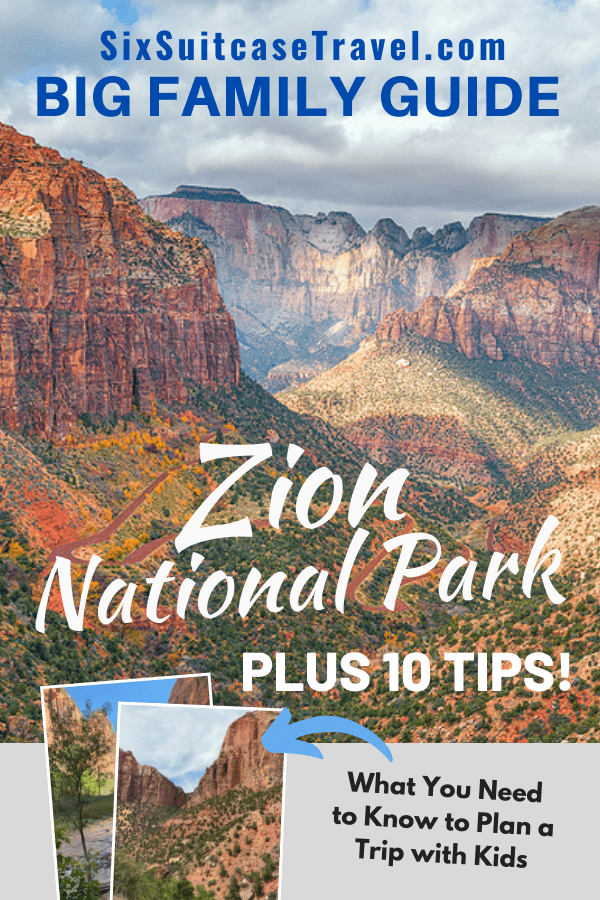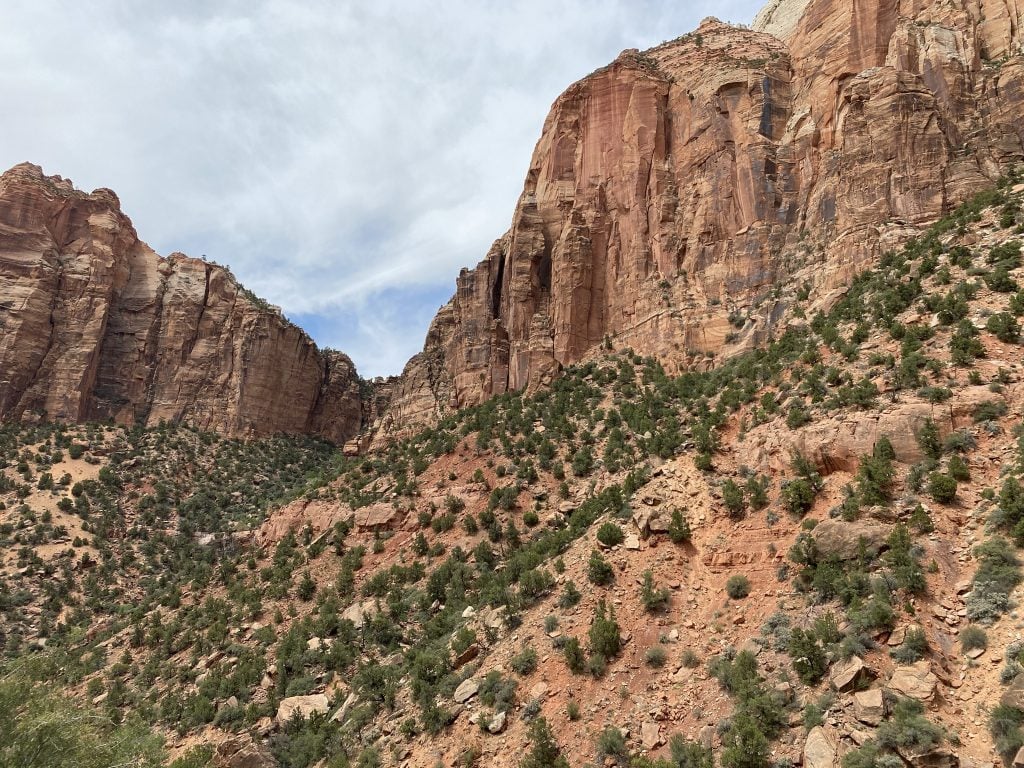
Located in southwestern Utah, Zion National Park’s dramatic landscape offers iconic scenery that calms the soul. Sheer sandstone cliffs, pine and juniper-dotted slopes, waterfalls, and rivers combine as gorgeous backdrops for a memorable vacation. There are many ways to explore the park; your family can enjoy hiking, biking, paddling, horseback riding, rock climbing, and more.
A visit to Zion can be part of a 6-park national park loop. We visited the park as part of a Grand Circle Tour road trip which includes Utah’s five national parks and the Grand Canyon. Of Utah’s Mighty 5 National Parks, Zion was my favorite. Zion offers enough hikes and activities to fill a 2-4 day itinerary. Whether you stay for one day or four, Zion should be on your family’s travel list. I hope you find the following information and tips for visiting with kids helpful.
With a mix of firsthand experience and in-depth research, we’ve compiled this guide to help your family explore the splendors of Zion National Park.
- Getting to Zion National Park
- How to Get around Zion National Park
- Best Hikes in Zion National Park
- How Many Days Do You Need at Zion National Park?
- Entrance Fees for Zion National Park
- Can You See Zion and Bryce Canyon in One Day?
- Best Time to Visit
- Best Sunrise and Sunset Points in Zion
- 10 Tips for Visiting Zion National Park
- Where to Stay at Zion National Park
Getting to Zion National Park
Zion National Park has three main entrances, each offering a different way to access the park. The South Entrance in Springdale and the East Entrance along the Zion-Mount Carmel Highway are connected by a scenic drive that takes you straight into the heart of the park’s main area, Zion Canyon, where most visitors spend their time.
If you’re driving from Las Vegas, you’ll likely enter through the South Entrance. If you’re coming from the Grand Canyon’s North Rim or Bryce Canyon, you’ll take the East Entrance, which offers a dramatic first impression as you wind through the Zion-Mount Carmel Tunnel into the park.
East Entrance
Traveling from the east, take State Route 9 west at the intersection with US-89/Mt. Carmel Junction. The park entrance is 13 miles west. This entrance features a 1.1-mile-long tunnel with some oversized vehicle restrictions, so be prepared if you’re driving an RV or trailer.
South Entrance
Get off Interstate 15 at Exit 16/State Route 9. The park is 20 miles east in Springdale, Utah. The South Entrance is the most popular access point to Zion National Park. Get off Interstate 15 at Exit 16/State Route 9. The park is located 20 miles east in Springdale, Utah. This entrance leads directly into the main canyon area, where you’ll find the visitor center, shuttle stops, and access to many of the park’s famous hikes and attractions. Exit off Interstate 15 at Exit 16/State Route 9. The park is 20 miles east in Springdale, Utah.
Konob Canyons Entrance
The Kolob Canyons entrance is located off Interstate 15 at Exit 40, approximately 40 miles north of Zion’s South Entrance. This entrance provides access to the beautiful and less crowded northwestern section of the park. While Kolob Canyons offers stunning red rock scenery, hiking trails like the Timber Creek Overlook and Taylor Creek Trail, and a scenic drive, it is important to note that this area is detached from the main Zion Canyon area. There are no direct road connections between Kolob Canyons and the park’s main entrance or shuttle system, so you’ll need to plan separate visits if you want to explore both areas
Park Distance from Nearby Cities and Parks
- Las Vegas to Zion is 167 miles or about a 2.5-hour drive.
- Salt Lake City to Zion is 308 miles or a 4.5-hour drive.
- Grand Canyon – South Rim to Zion is 241 miles or about a 4-hour drive.
- Bryce Canyon to Zion is 73 miles or a 1.5-hour drive.
How to Get around Zion National Park
Driving and Parking
Your initial drive through the park when entering from the east is along UT-9, Zion-Mount Carmel Highway and Tunnel. Several pull-outs give opportunities to stop and view the scenic overlooks. However, there isn’t much for parking.
Springdale and Park Shuttles
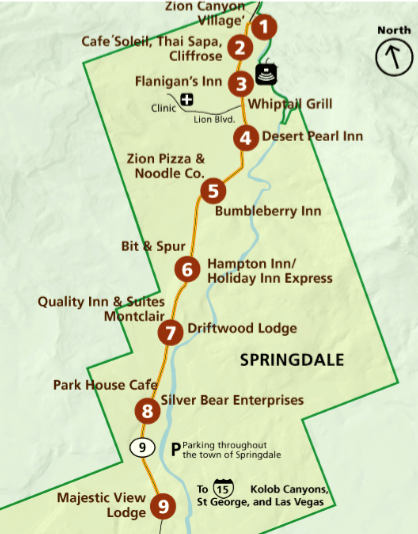
Springdale Shuttle to the Pedestrian/Bike Entrance
If you’re staying in Springdale, the local town shuttle (which is free) connects to the Visitor Center, making it convenient to access the park shuttle system without driving and dealing with parking limitations. This means you can use the Springdale shuttle to take you to the park’s pedestrian entrance, where you can board the Visitor Center shuttle.
Springdale Shuttle Tips
- Arrive Early: Even with a ticket, it’s best to arrive early, especially during peak times. This helps you avoid long wait times and ensures you get on the shuttle you want.
- Plan Your Stops: Map out your planned hikes or destinations in advance to get the most out of the shuttle system.
- End of Day Shuttles: Keep an eye on the schedule for the last shuttle of the day. Missing it means a long walk back (up to 8 miles).

Park Shuttle from Visitor Center up the Scenic Drive
Zion National Park operates a mandatory shuttle system to access the Scenic Drive, the main road through Zion Canyon, from spring through late fall. Private vehicles are not allowed on the Scenic Drive during this time to reduce congestion and protect the park’s environment. This means that visitors must use the shuttle to reach several of Zion’s most iconic trailheads, including stops like Zion Lodge, Emerald Pools, The Grotto, and the Temple of Sinawava, where the famous Narrows hike begins.
Ticketing System for the Shuttle
Unlike in previous years, there is no ticketing or reservation system for the shuttle this season. While this change allows for greater flexibility in planning your visit, it has also led to extremely long wait times at the shuttle stops, particularly during the busy summer months. Lines for the shuttle have been compared to those at popular theme parks, especially in the morning when many visitors arrive at the park. These delays can greatly impact your itinerary and limit the time available to explore.
Some tips to help navigate the current system:
- Arrive Early: The buses begin running as early as 6:00 or 7:00 AM, depending on the season. Arriving at the Visitor Center parking lot before the shuttles start running is crucial to avoiding the longest lines.
- Consider Starting Late: If you prefer to avoid the early-morning crowds, arriving later in the day, after the peak morning rush, can occasionally reduce your wait time. Note that this strategy works best during shoulder seasons or on weekdays.
- Be Prepared for Crowds: During the busiest times of day, from mid-morning to mid-afternoon, even shuttle stops within the park (e.g., Zion Lodge or Canyon Junction) may have long lines for the return trip to the Visitor Center.
Walk to Park Entrance
If your hotel is within a mile of the pedestrian bridge, we recommend walking to the park entrance instead of relying on the Springdale Town Shuttle. While the shuttle is free and convenient, it often fills up at stops further away from the park entrance. Hotels closer to the entrance are located near the end of the shuttle route, meaning there are often no seats available by the time it stops there. Walking allows you to bypass these crowds and ensures you don’t waste valuable time waiting for a shuttle, especially during peak hours.
Best Hikes in Zion National Park
When traveling with younger kids, any of the hikes listed below as easy are a good pick. For older kids, pick from moderate or strenuous hikes.
Zion National Park Easy Hikes With Kids
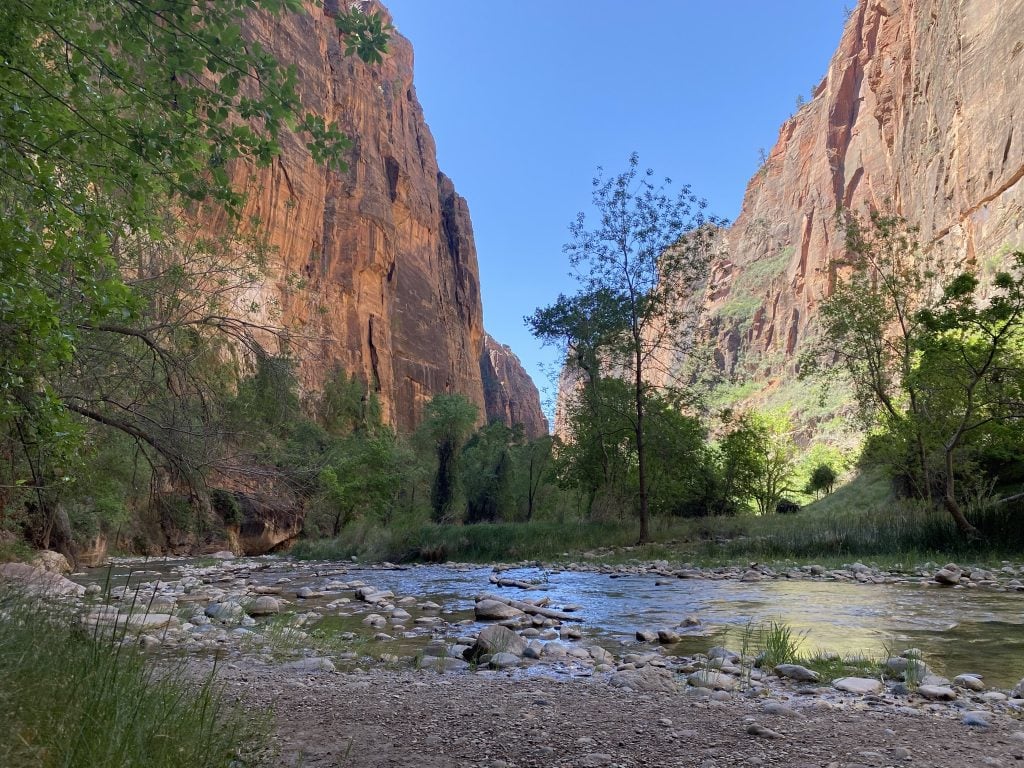
1. Riverside Walk
- Distance: 2.2 miles round trip
- Estimated Time: 1.5 hours
- Shuttle Stop: Stop 8 – Temple of Sinawava
- Trail Description: This paved trail is perfect for families and follows the Virgin River through the breathtaking narrows of Zion Canyon. Along the way, you’ll enjoy shaded areas, views of towering sandstone cliffs, and potential wildlife sightings. The walk ends at the start of The Narrows, so you can dip your toes in the river or stop for photos. The flat, wheelchair- and stroller-friendly path makes this trail especially ideal for families with young children. Bring plenty of water and sunscreen, as shade can be limited during certain times of the day.
2. Pa’rus Trail
- Distance: 3.5 miles round trip
- Estimated Time: 2 hours
- Shuttle Stop: Stop 1 – Zion Canyon Visitor Center
- Trail Description: The Pa’rus Trail offers a longer, but very gentle walk along the Virgin River, beginning at the Visitor Center and ending at Canyon Junction. The path is wide, paved, and open to both walkers and cyclists, making it a pleasant and accessible experience. It’s also the only trail in the park where leashed pets are allowed. Along the way, you’ll pass bridges, river views, and open vistas with the canyon walls rising around you. Consider renting bikes in nearby Springdale if you want to make this a quicker adventure.
3. The Grotto Trail
- Distance: 1-mile round trip
- Estimated Time: 30 minutes
- Shuttle Stop: Stop 6 – The Grotto
- Trail Description: This short, easy hike parallels the Scenic Drive and connects Zion Lodge and The Grotto Picnic Area. It’s a pleasant stroll through a shaded area with cottonwoods and lovely views of Zion’s towering red cliffs. Ideal for families looking for a quick and scenic trail, this walk can easily be paired with a picnic lunch at the nearby Grotto area, which has tables and restrooms.
4. Lower Emerald Pool Trail
- Distance: 1.2 miles round trip
- Estimated Time: 1 hour
- Shuttle Stop: Stop 5 – Zion Lodge
- Trail Description: The Lower Emerald Pool Trail is a family favorite, offering a relatively gentle hike to a picturesque pool located below the Middle Emerald Pools and waterfalls. The trail surfaces are paved with moderate inclines, making it accessible for families with small children. After reaching the pool, you’ll enjoy a stunning backdrop of sandstone walls and greenery. Be cautious near wet areas, as some sections of rock can become slippery. This trail is perfect for a mid-morning or late afternoon adventure.
Zion National Park Moderate Hikes
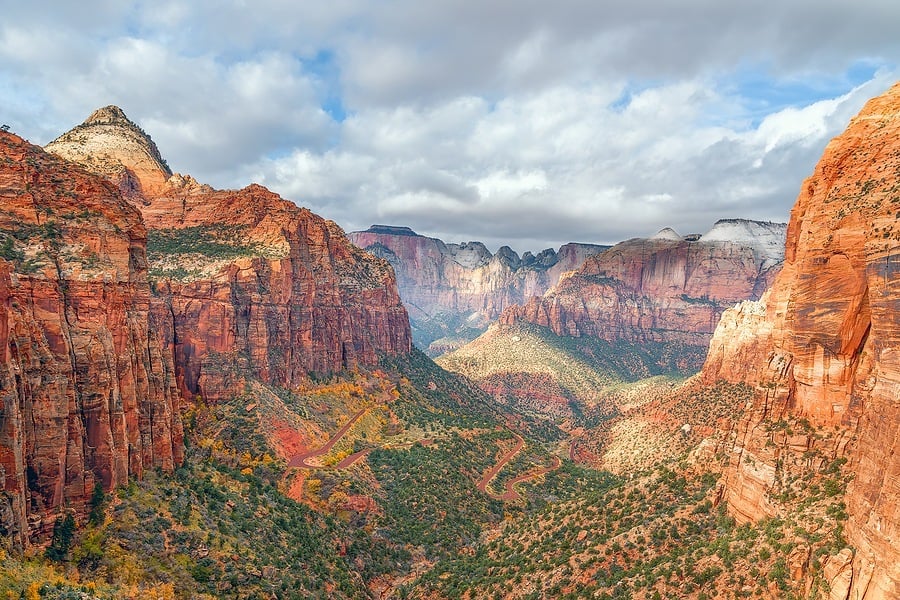
1. Canyon Overlook Trail
- Distance: 1 mile round trip
- Estimated Time: 1 hour
- Access: Drive along the Zion-Mount Carmel Highway (UT-9) to reach the trailhead.
- Trail Description: The Canyon Overlook Trail is one of the most iconic and beginner-friendly hikes in Zion National Park, offering absolutely stunning views of lower Zion Canyon. The trail is located near the east entrance of the historic Zion-Mount Carmel Tunnel (the trailhead parking is immediately after exiting the tunnel if you’re driving westbound). While short, the trail includes a moderate incline and rock stairs, along with some narrow sections with drop-offs. However, handrails are available on exposed sections, making it manageable for most hikers, including families with older kids.
- Parking: Parking is extremely limited near the trailhead. Arrive early, especially during peak season, to secure a spot. Otherwise, you may need to park further down the road and walk back to the start.
- Best Time to Hike: Early morning is the best time to hike, both to avoid crowds and to experience cooler temperatures.
- Amenities: There are no restrooms at the trailhead, so make sure to stop at the Zion Visitor Center or East Entrance facilities before heading out.
2. Upper Emerald Pool Trail
- Distance: 1 mile round trip
- Estimated Time: 1 hour
- Shuttle Stop: Stop 5 – Zion Lodge
- Trail Description:
The Upper Emerald Pool Trail climbs from the Lower Emerald Pool to a serene pool situated against a stunning cliff wall. The path is sandy and rocky, with gentle but noticeable inclines along the way. The final destination provides peaceful views of a shallow pool framed by the towering cliffs above, making it a refreshing stop for those who want a quieter, short hike. If you’re already exploring Emerald Pools, adding this trail is an easy and worthwhile extension. Note that the trail can be hot due to limited shade, so starting early or bringing plenty of water is recommended.
3. Kayenta Trail
- Distance: 2 miles round trip
- Estimated Time: 1.5 hours
- Shuttle Stop: Stop 6 – The Grotto
- Trail Description:
The Kayenta Trail connects the Grotto to the Emerald Pools Trail system and offers gorgeous views of the Virgin River and the valley below as it climbs gently uphill. It’s unpaved and moderately challenging, with some narrow paths along ledges, making it a good choice for hikers seeking a less crowded, quiet route compared to the main Emerald Pool trails. The trail eventually links to the Middle Emerald Pool Trail, allowing hikers to access a broader network of scenic areas. While the climb is steady, this trail is manageable for families with older kids
4. Middle Emerald Pool Trail
- Distance: 2.2 miles round trip
- Estimated Time: 1.5 hours
- Shuttle Stop: Stop 5 – Zion Lodge
- Trail Description:
The Middle Emerald Pool Trail offers a unique perspective of Zion, as it takes hikers to a sandstone ledge that overlooks the Lower Emerald Pools and features stunning canyon vistas. The trail, while unpaved, is relatively easy to follow, but it does involve some elevation gain, making it moderately challenging. Great views of the Virgin River canyon open up from the trail, allowing for excellent photo opportunities. To complete the Emerald Pool experience, you can pair this trail with the Lower or Upper Emerald Pool Trails. Watch for slick s
5. Watchman Trail
- Distance: 7.6 miles round trip
- Estimated Time: 4 hours
- Shuttle Stop: Stop 5 – Zion Lodge
- Trail Description:
The Sand Bench Trail is a unique hike that takes adventurers atop a massive landslide under The Sentinel, offering a different perspective of Zion’s geology and terrain. This unpaved trail features soft sand, which can make hiking more difficult, so it’s considered moderate despite its limited elevation gain. During the warmer months (March to October), parts of the trail are shared with commercial horseback tours, so be aware of this if you’re hiking on foot.
Zion National Park Strenuous Hikes
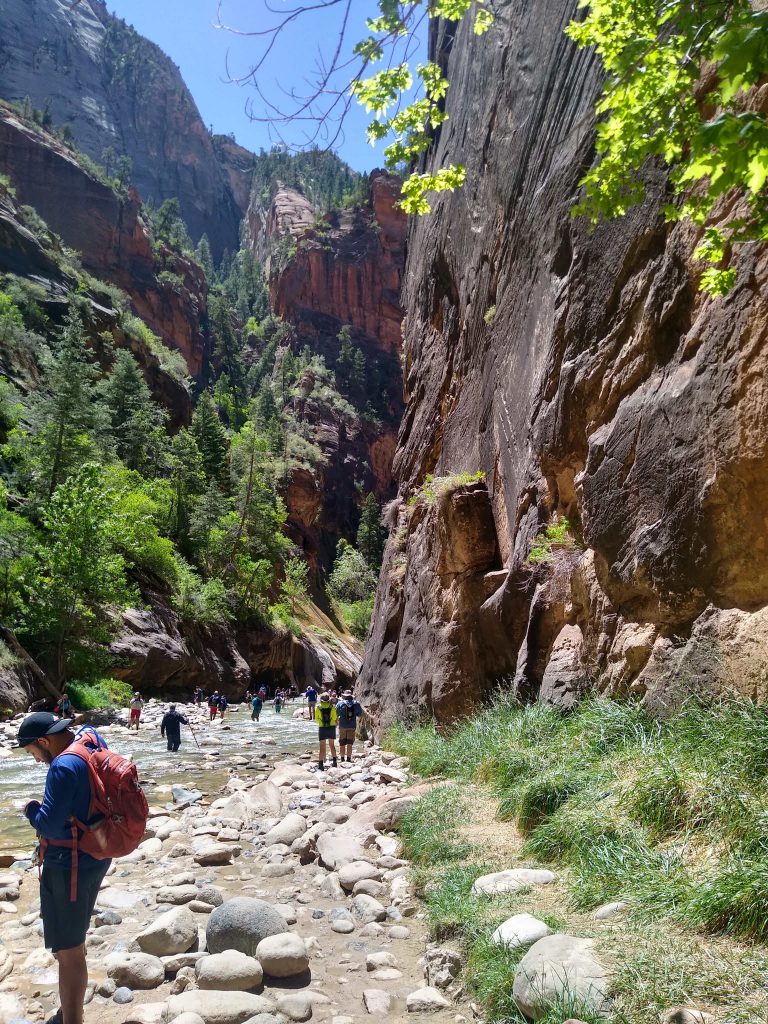
1. The Narrows
- Distance: Up to 9.4 miles round trip (hike as far as you like)
- Estimated Time: 8 hours for the full hike; varies depending on how far you go
- Shuttle Stop: Stop 8 – Temple of Sinawava
- Trail Description: The Narrows is not just a hike—it’s an unforgettable adventure wading through the Virgin River between towering canyon walls. Starting at the end of the Riverside Walk (a flat, paved trail leading to the trailhead), you’ll walk directly into the river itself. The depth of the river varies seasonally and can range from ankle-deep to chest-high in some sections. Along the way, you’ll experience breathtaking views of the narrowest parts of Zion Canyon, with walls rising up 1,000 feet on either side.
- What to Know Before You Go:
- Permits: A permit is NOT required for the bottom-up hike starting at the Temple of Sinawava. Permits are only required for the top-down hike, which starts upstream at Chamberlain’s Ranch.
- Wear Appropriate Gear: Sturdy, water-resistant footwear is essential. Consider renting neoprene socks and canyoneering boots to stay comfortable and stable.
- Check River Conditions: The hike is weather-dependent, as flash floods can occur during storms. Always check the flash flood forecast at the Visitor Center before starting.
- Turn Around When Necessary: This hike is not a loop, so you will return the same way you came. Keep this in mind when deciding how far to go, and plan your energy levels and time accordingly.
- Safety Tips:
This hike is best suited for older, steady-footed children and adults, as navigating slippery underwater rocks can be tricky.
Be prepared for cold water temperatures, even in summer.
2. Angels Landing
- Distance: 5.4 miles round trip
- Estimated Time: 4–5 hours
- Shuttle Stop: Stop 6 – The Grotto
- Trail Description: Widely regarded as one of the most exhilarating and iconic hikes in the National Park System, Angels Landing is not for the faint of heart. The trail begins at The Grotto and follows the West Rim Trail, climbing steep switchbacks, including the famous Walters Wiggles, to reach Scout Lookout. At this point, the trail narrows significantly, with sheer drop-offs of 1,000 feet or more on both sides. The final half-mile features chains bolted into the rock for hikers to hold onto as they navigate the narrow ridge to the summit.
- The incredible panoramic views from the top of Angels Landing make the challenging and thrilling climb worthwhile. However, it is a trail that demands focus, care, and preparation, and it is not recommended for young children, people afraid of heights, or during times of heavy wind or rain.
- What to Know Before You Go:
- Permits Required: As of April 2022, a permit system is in place for Angels Landing to manage crowding and enhance safety. Permits must be applied for during a seasonal lottery or as part of a day-before lottery. Visit the park’s website or recreation.gov for details.
- Hiker Traffic: Expect to encounter other hikers along the narrow ridge, as this is one of Zion’s most popular hikes. Patience and courtesy are essential when passing others.
- Fitness & Preparedness: This trail requires a significant level of physical and mental fitness. Rest frequently and bring plenty of water and snacks to fuel your climb.
- Turn Around If Uncomfortable: If you reach Scout Lookout and are unsure about completing the ridge portion with chains, you can turn back here. Scout Lookout still offers excellent views and a rewarding experience.
How Many Days Do You Need at Zion National Park?
If your big family visits first thing in the morning, you can cover Zion National Park in one day with a few easy hikes. However, during the busier months, shuttle lines can be long which will greatly impact your activities. One way to avoid the shuttles is to rent bikes, however, you are then sharing the narrow roads with the buses. Below are our recommendations for one-, two-, and three-day itineraries.
Zion National Park One-Day Itinerary
Start your day early, arriving at the Visitor Center between 7 AM and 10 AM to beat the crowds and make the most of your time. Hop on the shuttle to the Temple of Sinawava and begin your adventure with the Riverside Walk. This 2.2-mile round-trip, stroller-friendly hike is perfect for families with small children, offering stunning views of the Virgin River and towering sandstone cliffs.
By midday, take a break and return to the Visitor Center for a relaxing lunch at the designated picnic areas. Alternatively, head into nearby Springdale to enjoy a meal or to your hotel for naptime before continuing your exploration of the park.
In the afternoon, for a moderate activity, consider hiking the Pa’rus Trail, the park’s only pet- and bike-friendly trail. This flat, scenic pathway follows the Virgin River and is great for families with older kids or leashed pets. For those seeking a more active option, tackle the Lower Emerald Pool Trail. This 1.2-mile round-trip hike features gentle inclines and leads to beautiful waterfalls and lush greenery.
As the evening cools, consider stargazing along the Pa’rus Trail, which offers fantastic, unobstructed views of the night sky. Another great option is to find a spot at one of Zion’s iconic viewpoints and watch the sunset cast its golden glow over the magnificent canyon walls.
Zion National Park Two-Day Itinerary
In addition to the above, add some of the following activities for your second day.
Start your morning with a more challenging or time-consuming hike, like The Narrows, especially if your group is up for an adventurous experience. Begin at the end of the Riverside Walk and wade into the water, going as far as is comfortable. Remember that when you decide to turn around, you’re only halfway through, as you’ll need to hike back to the trailhead. For families with younger kids or those seeking a more accessible option, the Pa’rus Trail offers a flat, scenic riverside walk that is both relaxing and beautiful.
By midday, head to the Human History Museum to take a break from hiking and learn about Zion’s cultural and natural history through exhibits and a short film.
In the afternoon, drive to the East Entrance of Zion to experience the Canyon Overlook Trail, a short yet moderate hike that rewards you with breathtaking views of lower Zion Canyon and its surrounding landscapes.
In the evening, unwind by the Virgin River at picnic areas like The Grotto or the Visitor Center. Let the kids play along the riverbank while you relax and enjoy the sunset reflecting off Zion’s canyon walls. Alternatively, attend a ranger-led program at the amphitheater near Watchman Campground or the Visitor Center (seasonally available), where you can learn more about the park in an educational and engaging setting.
Zion National Park Three-Day Itinerary
On your third day, drive over to the Kolob Canyons section of Zion National Park, located about 40 miles north of the main canyon entrance via Interstate 15 (Exit 40). This quieter, less crowded area offers stunning red rock formations and a chance to experience Zion’s beauty away from the crowds. Start at the Kolob Canyons Visitor Center, where you can gather trail maps and check for current conditions. Then, embark on the Kolob Canyons Scenic Drive, a picturesque 5-mile road that winds through towering sandstone cliffs and lush desert landscapes, with plenty of turnout spots for photos. For an unforgettable hike, tackle the popular Taylor Creek Trail, a moderate 5-mile round-trip that takes you along a peaceful stream, past two historic homestead cabins, and ends at the majestic Double Arch Alcove. This hike is ideal for families with older kids.
Entrance Fees for Zion National Park
We highly recommend buying an America the Beautiful pass for $80. The pass is good for one calendar year and is your ticket to more than 2,000 federal recreation sites. Having a pass will allow you to pop in for a few hours in the evening and again the next morning.
If you have a 4th grader, check out the FREE Annual 4th Grade pass which is good for the duration of the school year through the following summer (September-August).
Current U.S. military members and their dependents in the Army, Navy, Air Force, Marines, Coast Guard, and Space Force, as well as Reserve and National Guard members, qualify for a free annual pass.
Can You See Zion and Bryce Canyon in One Day?
No, I would not recommend trying to see Zion and Bryce Canyon in one day. Even without any hiking, the summer crowds and distance between parks mean that trying to visit both parks in one day is not worth your time. Visiting both parks over two days can be done.
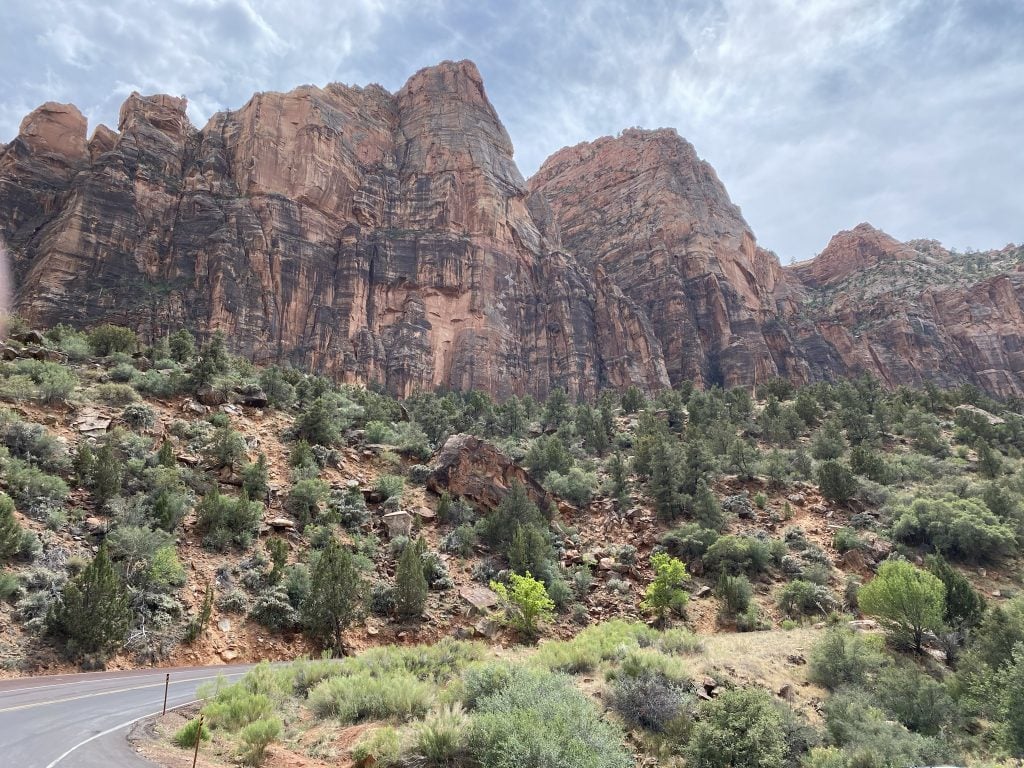
Best Time to Visit
The best time to visit Zion National Park depends on what you’re looking for, but spring (March to May) and fall (September to November) are widely regarded as the ideal seasons. During these times, temperatures are mild, usually ranging from 50°F to 80°F, making it perfect for hiking and exploring. In spring, the snowmelt brings vibrant greenery and flowing waterfalls, while fall adds stunning hues of red and gold to the canyon’s landscapes. These seasons tend to draw significant crowds, especially in late spring and early fall, so arriving early in the day can help you beat the rush. Additionally, trails like The Narrows may be safer in late spring due to moderate water levels, and fall is perfect for photography because of the changing colors and softer light.
Summer (June to August) brings soaring temperatures, often exceeding 100°F, and the park experiences its highest visitation. Long shuttle lines and crowded trails are common, especially in the mornings. Early hikes and proper hydration are critical during these hot months.
Winter (December to February), on the other hand, offers a much quieter experience, with significantly reduced crowds and cooler conditions, though mornings and evenings can be frigid, with occasional snow at higher elevations. For those looking for solitude, winter is ideal, while the convenience of private vehicle access up the Scenic Drive adds flexibility. Ultimately, October is often considered one of the best months overall, blending cooler weather with fewer visitors and vibrant scenery, but Zion’s beauty offers something unique during every season.
Best Sunrise and Sunset Points in Zion
Viewing sunrise and sunset in Zion National Park is a unique experience because of the towering sandstone cliffs that block much of the horizon, creating dramatic displays of light and shadow on the canyon walls. Instead of watching the sun crest the horizon, you’ll witness the cliffs gradually illuminated in warm, glowing hues or fading into darkness
Sunrise Viewing Spots
- Human History Museum Patio (ADA Accessible): This spot offers breathtaking views of morning light chasing away the shadows from the famous Temples and Towers. For a special experience, visit a few days after a full moon to see the moon set behind the cliffs as the sun rises.
- Canyon Overlook Trail: A moderate, 1-mile round-trip hike on the east side of Zion that provides spectacular views as sunlight filters into Zion Canyon. Parking is limited, so plan accordingly.
- Lava Point Overlook: Located along the Kolob Terrace Road, this spot provides sweeping views as the rising sun illuminates the plateaus and canyons. Lava Point closes seasonally when snow falls, so check conditions before visiting.
Sunset Viewing Spots
- Pa’rus Trail: This paved, 3.5-mile round-trip path along the Virgin River offers phenomenal sunset views as golden light washes over The Watchman. It’s an easy and accessible option for families and photographers.
- Timber Creek Overlook Parking Lot (ADA Accessible): Located at the end of the Kolob Canyons Scenic Drive, this overlook showcases stunning sunlight and shadows playing across the Kolob Canyons’ iconic finger canyons.
- Lava Point Overlook: Lava Point isn’t just for sunrise! Enjoy the setting sun casting its final golden rays across Zion’s plateaus and canyons.
10 Tips for Visiting Zion National Park
- Arrive Early to Beat the Crowds
Zion is one of the most visited national parks in the U.S., with over 4 million visitors annually, meaning it can become crowded quickly, especially during peak season (spring, summer, and fall). Arriving by 7:00 AM is highly recommended to secure parking at the Visitor Center and minimize wait times for the shuttle. Early mornings also offer cooler temperatures, making it the best time to start hiking or enjoying the park’s quieter atmosphere. - Use the Shuttle System Wisely
The mandatory park shuttle is the only way to access the Scenic Drive and its iconic trailheads during peak months. Plan your stops ahead of time, as popular trailheads like Angels Landing and The Narrows get busy early. Be prepared for long shuttle lines, especially in the late morning or early afternoon. Consider hopping off at less busy stops, like The Grotto, and starting your hikes there to avoid crowds. - Stay Hydrated and Pack Snacks
Zion’s desert environment can lead to rapid dehydration, especially in the summer months when temperatures regularly exceed 100°F. Carry plenty of water—at least one gallon per person per day—and refill at water stations available at shuttle stops like the Visitor Center and The Grotto. Pack portable energy snacks to sustain you during hikes, as there are limited food options within the park itself. Always use reusable water bottles to minimize waste. - Plan Your Visit Based on Skill Levels
Zion offers trails for all levels of hikers. For families with young children, stick to easy, accessible trails like Riverside Walk or the Pa’rus Trail. Older kids and adventurous teens might enjoy moderate trails like the Kayenta Trail or Upper Emerald Pool Trail. For experienced hikers, don’t miss strenuous options like Angels Landing (permit required) or The Narrows. Research trails ahead of time, as some—such as Angels Landing—may not be suitable for those afraid of heights or inexperienced hikers. - Check the Weather and Flash Flood Forecast
Zion’s slot canyons, including The Narrows, are susceptible to flash floods during storms. Even if no rain is falling in the park, upstream rainstorms can trigger sudden flooding in canyon areas, putting hikers in serious danger. Always check the weather and flash flood forecast at the Visitor Center before venturing into high-risk areas, and be prepared to change plans if conditions aren’t safe. - Dress Comfortably and Wear the Right Gear
Zion’s terrain varies significantly, with hiking conditions ranging from sandy paths to rocky riverbeds. Wear sturdy, well-broken-in hiking shoes, and consider renting canyoneering boots and hiking poles if venturing into The Narrows. In the summer, lightweight, moisture-wicking clothing and UV-protective hats are essential, while winter visitors should bring layers to prepare for cold mornings and evenings. - Book Lodging or Campgrounds in Advance
Zion is an incredibly popular destination, and accommodations in Springdale (just outside the park’s south entrance) book up months in advance, especially during peak travel seasons. If you plan to camp, Watchman Campground and South Campground also require reservations, which can be made up to six months ahead of time. For larger families, consider vacation rentals or big-family-friendly hotels nearby. - Don’t Forget Your Annual Pass (or Consider Buying One)
It covers entry to more than 2,000 federal recreational sites across the U.S. Families with fourth-grade students can take advantage of the Every Kid Outdoors program, which provides free passes for fourth-graders and their families. - Prepare for Long Shuttle Lines and Parking Challenges
The park fills up quickly during peak seasons, and shuttle lines can become Disney Park-level long. If you’re staying within walking distance of the park entrance (in Springdale), walking or biking is often faster than waiting for the Springdale Town Shuttle, which fills up at earlier stops. Visitors driving in should plan to arrive early, as the Visitor Center parking area fills by mid-morning, forcing latecomers to use paid parking in Springdale, which can cost around $30. - Slow Down and Enjoy the Views
While Zion is known for its thrilling hikes like Angels Landing, don’t rush through your visit. Not all experiences need to be physically demanding. Take time to enjoy the smaller moments—relax by the Virgin River, have a picnic near The Grotto, or sit quietly at one of the overlooks to soak in the breathtaking canyon views. Stargazing in Zion is also a special treat, with excellent views from Pa’rus Trail or the museum patio. Zion is as much about peaceful, quiet appreciation as it is about adventure.
Where to Stay at Zion National Park
Big family friendly hotels near Zion
Zion Lodge located inside the park does not have rooms to sleep six or more. Check out our listings in Springdale, UT for big families.
Camping and RV
South Campground
Campground is open from March to the end of October. Reservations must be made online up to two weeks in advance. The campground offers 112 tent campsites and 9 RV/Motorhome sites.
Watchman Campground
Located near the park’s south entrance, the campground is a short walk from the main visitor center. The campground has 190 regular sites and 91 RV/Motorhome sites. Sites can be booked up to 6 months ahead.
Vacation Rentals
If you need more room, a nearby vacation rental can be your home base for your visit.
Pin for later!
